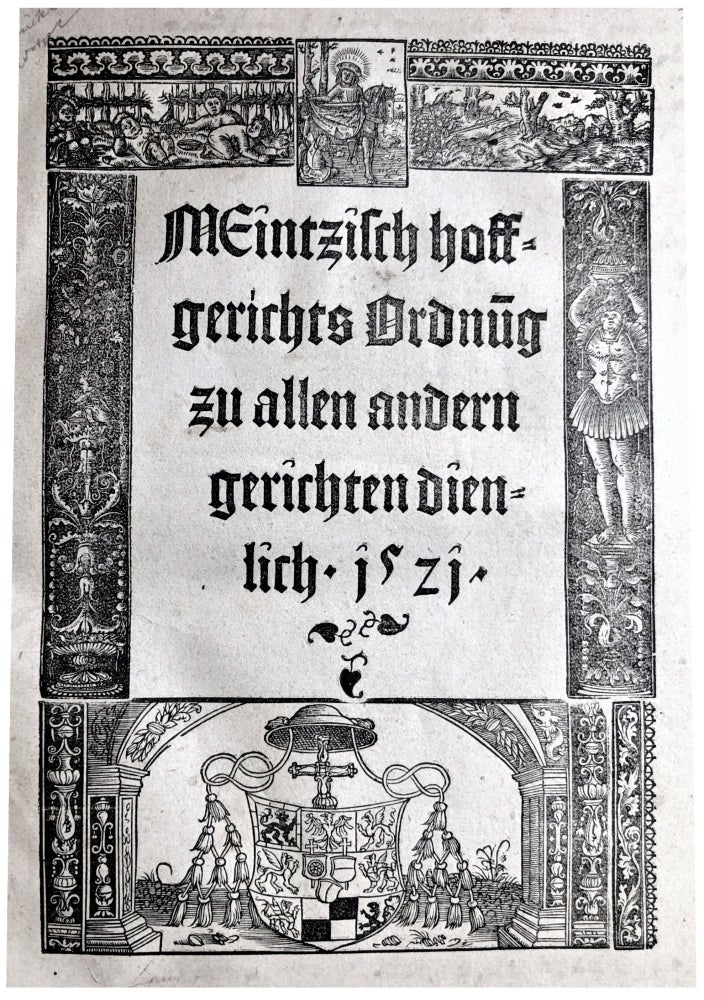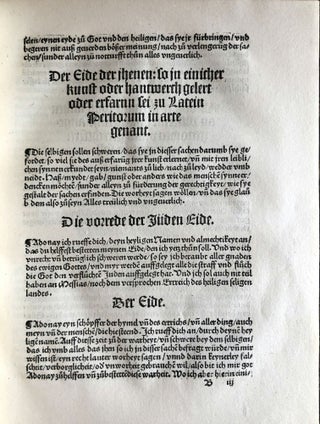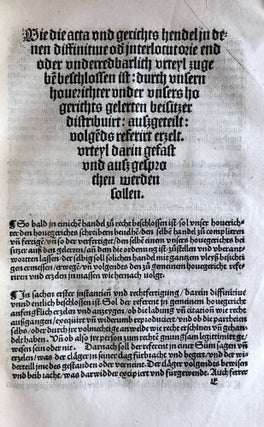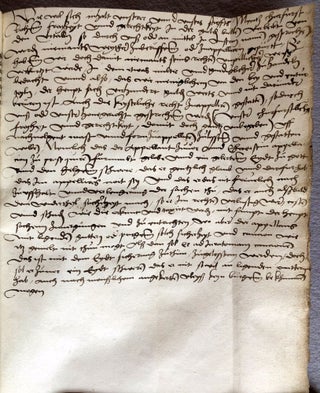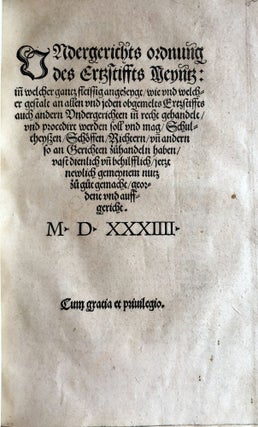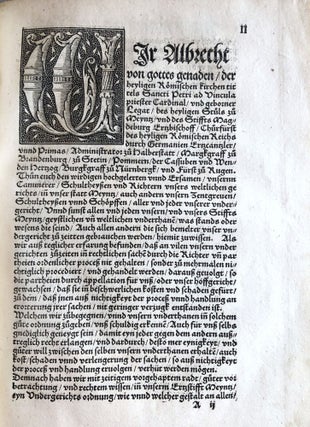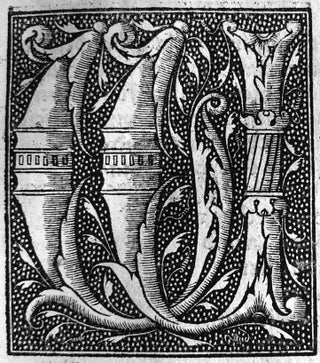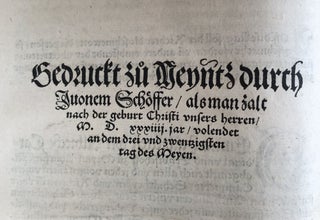Meintzisch hoffgerichts Ordnu(n)g zu allen andern gerichten dienlich. Mainz: Johann Schöffer, 4 September 1521.
[Bound with:] Undergerichts ordnung des Ertzstiffts Meyntz. Mainz: Johann Schöffer, 23 May 1534.
2 vols. in one, small folio (278 x 193 mm). 1) [23] leaves (of 24, final blank removed). Woodcut title border composed of nine blocks. incorporating whimsical scenes, ornamental borders, and at bottom the arms of the Archbishop-Elector Albrecht of Brandenburg, gothic types, two typographic(?) Fraktur initials. Bound at end is a leaf with a one-page contemporary manuscript commentary (wider than the text block and folding). Title-leaf rehinged, slightly darkened, and with effaced marginal inscriptions, initial on A2r hidden in gutter, initial on A2v shaved, quire E with a couple of small corner repairs. 2) 35 leaves (of 36, final blank removed). Large woodcut white-on-black pointillé opening initial, Fraktur initials throughout. Marginal dampstaining, last quire on a guard. Early 20th-century pastepaper over boards, manuscript spine label.
First Edition of the judicial statutes of the Electorate of Mainz, the largest ecclesiastical province of Germany and one of the most prestigious and powerful states of the Holy Roman Empire; bound with the First Edition of the statutes of the lower court of the Mainz Prince-Bishopric (or Erzstift). The archbishops under the Holy Roman Empire wielded secular as well as pastoral power. Part of the Emperor’s program of consolidation of the far-flung empire was the codification and standardization of provincial laws. Both these procedural codes explicitly adopted the ius commune (gemeines Recht), a combination of Roman and canon law. Both establish precise rules for court procedure and include copious down-to-earth details, including where the courts reside, who should serve in them, and how trials are to be conducted. As is common for German law books, these editions are handsomely printed.
1) The Mainz Hofgerichts Ordnung was drawn up in 1516 by Albrecht of Brandenburg, Archbishop and Elector of Mainz (and by his chancellor Johann Fürderer), and approved in 1521 by the Emperor Charles V. The latter’s ratification is printed at the beginning and end of the statutes. These cover the location of the court, required functionaries (a judge and a jury of at least 11 members of the nobility, although a Doctor or university graduate would suffice), duties of other judicial administrators including the court scribes, frequency and timing of sessions, and jurisdiction by subject and area. Also included are a dozen varieties of oaths, for different court officials (including the scribe) and for special segments of the population, e.g., poor people, witnesses, legal representatives, and Jews, for whom there is a special preface to the oath itself, in which the Jewish defendant or witness must swear that should he not be telling the truth he must renounce all rights to the Holy Land or to participation in the coming of the Messiah. One statute establishes the right of the poor to legal representation, which must be covered by the court. Procedural instructions are provided for every activity and eventuality, including the recording of testimony of plaintiffs and witnesses, fines and punishments for those who don’t show up at court, proper written documentation and forms, rules for appeals, execution of sentences, and payment of attorneys.
OCLC lists three copies in the US (Harvard Law, LC and Indiana U.). VD 16 M 262; Otto Stobbe, Geschichte der deutschen Rechtsquellen (1860-64) 2: 410-11.
2) The 1534 lower court rules prescribe further details for the conduct of court business. These include how to handle the “law books,” i.e., the court records, which are to be maintained in “two volumes with locks, kept in a safe place...” (f. 4r); more procedures to follow for uncooperative defendants (a long section: evidently a common occurrence); bonds and bail; more oaths; and formularies for various charges, appeals, and judgments. These Mainz laws were adopted in 1538 by the archdiocese of Cologne, and influenced other lower court statutes, including those of Württemberg, issued in 1555 (Stintzing).
OCLC locates one US copy (Harvard Law). VD 16, M 273; Stobbe 2: 258 (note) & 411; Stintzing and Landsberg, Geschichte der deutschen Rechtswissenschaft (1880), I:543.
Price: $3,800.00

